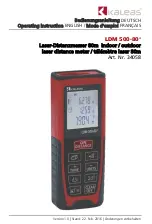
XT2640 Operating Manual
13 July 2016
Page 149 of 187
24.4.10
MEASUREMENT
CONFIGURATION
QUERY
COMMANDS
These commands respond with the requested configuration being used at the time of the command, not including any unsaved
changes.
These commands which have a VDEF field will raise an error if the VDEF field defines a VPA which is not available.
These commands which have a CDEF field will raise an error if the CDEF field defines a channel which is not installed.
COMMAND
KEYWORD
FIELD(s)
FIELD
FORMAT
FIELD
DATA
RANGE
DESCRIPTION
ADJUST?
v
VDEF
‐
Responds with the NR1 adjustment setting for VPA
v
–
0: No adjustments are made
1: adjusts the A signal to compensate for the V input current when V is connected
at the source and
you require the results at the source (the V current is added to
the A signal)
2:
adjusts the V signal to compensate for the A input drop when V is connected at
the load and you require the results at the source (the A drop is added to the V
signal)
3:
adjusts the V signal to compensate for the A input drop when V is connected at
the source and you require the results at the load (the A drop is subtracted from
the V signal)
4:
adjusts the A signal to compensate for the V input current when V is connected
at the load and you require the results at the load (the V current is subtracted from
the A signal)
ARANGE?
c
CDEF
‐
Responds with the NR1 current input range setting for channel
c
–
0: Set for the HI range
1: Set for the LO range
2: Set for auto‐range, using the HI range
3: Set for auto‐range, using the LO range
ASCALE?
c
CDEF
‐
Responds with the current scaling and offset settings for channel
c
in two fields –
1
st
NR3 : current scaling setting (0.0 if not configured for scaling and offset)
2
nd
NR3 : current offset setting (0.0 if not configured for scaling and offset)
BANDWIDTH?
v
VDEF
‐
Responds with the NR1 Bandwidth Limit setting for VPA
v
–
0: Auto‐Track Bandwidth Limit
1: No bandwidth limit
2: Fixed frequency bandwidth limit, this is followed by a NR3 field containing the
bandwidth limit frequency in Hz.
CHANNELS?
v
VDEF
‐
Responds with the NR1 channel inclusion setting for VPA
v
–
0: none
1 through 15: additive channel selection, CH1=1, CH2=2, CH3=4, CH4=8
COUPLE?
v
VDEF
‐
Responds with the NR1 default measurement result coupling setting for VPA
v
–
0: AC+DC
1: AC Only
2: DC Only
DIGITS?
v
VDEF
‐
Responds with the NR1 displayed digits setting for VPA
v
DIR?
‐
‐
‐
Responds with the NR1 DIR input polarity setting (DIR command)
EFFGROUP?
v
VDEF
‐
Responds with the NR1 efficiency group setting for VPA
v
–
0: None
1: IN
2: MIDDLE
3: OUT
FUND?
v
VDEF
‐
Responds with the fundamental frequency setting for VPA
v
as two fields, the 1
st
field is a NR1 and the 2
nd
is a NR3 –
NR1 value ‐
0: No fundamental, NR3 is 0.0
1: Fixed fundamental, NR3 is the fixed value
2: V input measurement, NR3 is the maximum limit
3: A input measurement, NR3 is the maximum limit
4: MAINS, NR3 is 0.0
5: AVIONICS, NR3 is 0.0
6 through 8: Use VPA1 through 3 resp. as the fundamental frequency, NR3 is 0.0
9 through 11: Use GFUND1 through 3 resp. as the fundamental frequency, NR3 is
0.0
HARMS?
v
VDEF
‐
Responds with the NR1 maximum number of harmonics setting for VPA
v
INTEGAUTO?
‐
‐
‐
Responds with a NR1 if integration is automatically controlled (1) or manually
controlled (0)
INTEGDELAY?
‐
‐
‐
Responds with four NR1 values for the automatically controlled integration delay
time (days, hours, minutes and seconds respectively).
INTEGRUN?
‐
‐
‐
Responds with four NR1 values for the automatically controlled integration run
time (days, hours, minutes and seconds respectively).
LOGDATA?
‐
‐
‐
Responds with the presently defined data content in each data logging record –
1
st
field (NR1) indicates if time and date is included (1) or not (0)
2
nd
through 17
th
fields (STRING) indicate the definition for each data field in the
record (a blank field in the response indicates that the field is not included in the
record)
















































